 Build cool Web sites without coding its easy with Joomla! Joomla! makes it easy, and this book makes it easier yet!
Build cool Web sites without coding its easy with Joomla! Joomla! makes it easy, and this book makes it easier yet!
Learn to:Plug it in check into plug-ins, components, and additionalmodules to see how they differ and what they can dofor more!Create interactive Web sites with Joomla!
Choose the correct modules, components, and plug-insInclude discussions, polls, RSS feeds,and moreDevelop sites with optimum search engine visibility Part I: Get ting Star tedwith Joomla In this part... This part is where you begin putting Joomla to work. First, we give you an overview of Joomla as itsused today around the world. Then we show you how to get and installJoomla or how to get other people to do the work for you (on paysites)! Finally, we dig into Joomla by helping you master the home page of any Joomla site the front page, in Joomla lingo. You see how to add your own text to the front page,change the front pages logo, sling the menu items around, and more.
Chapter 1
Essential Joomla
In This Chapter Discovering Joomla Viewing some example sites Knowing what content management systems do Finding out why Joomla is so popular Preparing to use Joomla The head Web designer walks into your sumptuous office and says, We landed the MegaSuperDuperCo account.
Thats good, you say. They want you to design their new Web site. Thats good, you say. They want to use a CMS. Thats bad, you say. Whats the problem? the head Web designer asks.
You shift uncomfortably. Well, I have no idea what a CMS is. The head Web designer laughs. Thats no problem. Its a content management system. You know like Joomla.
Like whomla? you ask. The head Web designer tosses a folder on your desk.Take a look at these sample sites. Joomla provides an easy frameworkfor managing the content of your Web site. You type in the content, andJoomla takes care of displaying it for you. You pick up your cup of coffee as the head Webdesigner leaves and start leafing through the pages. Some of the Websites are snazzy.
Then you turn to your computer and start enteringURLs. Welcome to Joomla! As the head Webdesigner said, Joomla is a content management system (CMS), which meansthat after you set the site up, you (or your clients) are responsibleonly for entering text and figures. Joomla arranges the content, makesit searchable, displays it, and generally manages the Web site. Youneed little or no technical expertise to create and manage your ownsites. Setting up a cool site from scratch is not easy especially if you want to keep that site updated. A person who runs anewspaper site with about 6,000 visitors a day once came to us utterlyexhausted.
It turned out that he was formatting his entire site fromscratch, using HTML, which meant that he had to get up at five everymorning to enter the news stories in HTML tables and format them forhis Web site. He still had his day job (he wanted to quit, but the newssites advertising was just ramping up) and found that he was working atotal 14 hours every day. Joomla was the answer for him. Now all he has to dois copy and paste the stories into Joomlas Article Manager and click afew options. The stories are published no fuss, no muss. Sample Joomla Sites A great way to get to know Joomla is to take a lookat what its capable of, which means taking a look at someJoomla-powered sites.
The following sections introduce a few examples. City of Longwood (Florida) First, check out the City of Longwood Web site atwww.longwoodfl.org (see Figure 1-1). The home page has a navigation barof drop-down menus across the top and a menu of quick links on theright, some nice photos, a custom logo, and even a search box. The site is well balanced, giving the impression ofprofessionalism, and its powered by Joomla, which is operating behindthe scenes. You cant tell just by looking that the content of the page the text, photos, and menus is actually stored in a database.Joomla handles all the details. 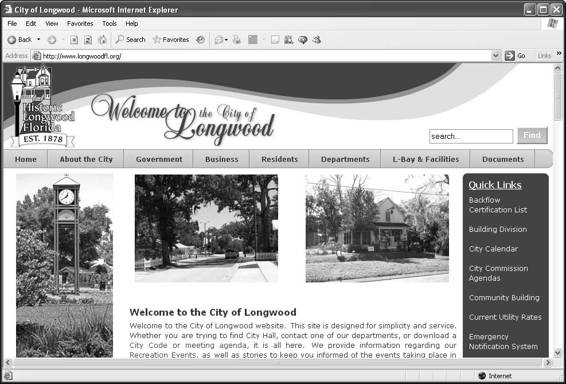
Chapter 1: Essential Joomla
AnotherJoomla-powered site is NZMac.com, which caters to the New ZealandMacintosh community, at www.nzmac.com (see Figure 1-2).
This site is another good one, with a top menu bar,a login box, a Main Menu box, and even a Recent Topics box. This siteis also powered by Joomla, even though it looks different from the Cityof Longwood site. This difference is one of the strengths of Joomla:Its easy to customize. Royal Oak Public Library Now take a look at www.ropl.org, the Royal Oak (Michigan) Public Library site (see Figure 1-3). This site is another well-designed one, with plentyof fresh content. Joomla excels at keeping site content up to date andmakes the process easy.
Jenerate and Everything Treo Two other good examples are Jenerate.com at www.jenerate.com (see Figure 1-4) and Everything Treo at www.everythingtreo.com. All these Web sites look professional, and theyalso look different. Yet they all use Joomla as their contentmanagement system. So just what is a CMS, and how does it work? 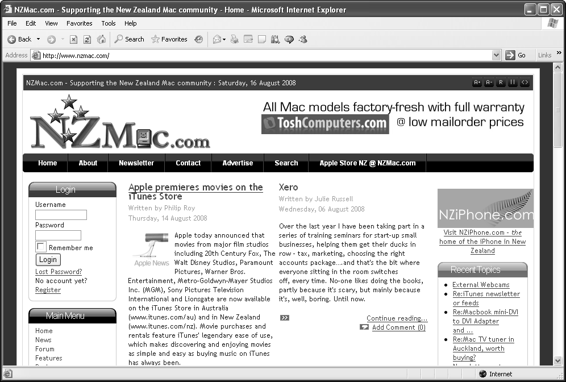
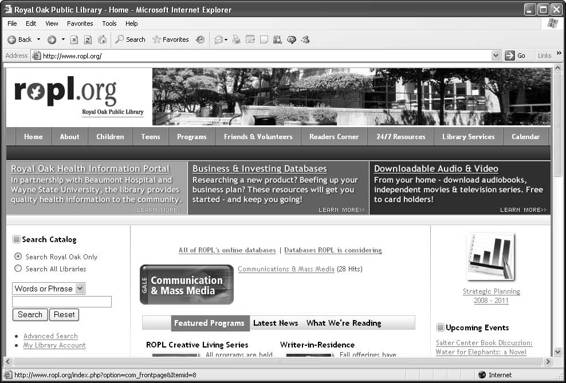

Chapter 1: Essential Joomla
All about Content Management Systems When the Web was young, static Web pages were all that anyone needed. These pages could be hand-entered in HTML for display in a browser, like this: Thatkind of page served its purpose well for small sites. It gave people aWeb presence and allowed them to display some images or maybe even adda little JavaScript to bring the page to life.
But as the Web grew and pages got larger andlarger, people discovered an inherent problem: They had to mix the HTMLthat handled the visual presentation in a browser with the data thatwas displayed. This mix made Web pages hard to maintain and update,because site owners were working with both text data and HTML. To handle this issue, Web designers created Cascading Style Sheets (CSS). CSS became primarily responsible for presenting thedata in a Web page, although that page was still written in HTML, asfollows: Now the presentation details were separated fromthe formal HTML structure of a page tags such as , , and . But the actual content of the page wasstill wrapped up in the HTML; site owners had to format the content byputting in the HTML tags. In other words, the addition of CSSremoved the presentation details from the rest of the Web page but hadnt yet separated the content from the HTML.
Chapter 1: Essential Joomla
That situation was a problem for nontechnicalpeople, who didnt want to have to fit their text into HTML tags.
Afterall, when someone writes a book report, he doesnt have to worry aboutenclosing each paragraph in elements, or stylingtext with
or class elements. Thats whereCMSes came in.
The whole idea of a CMS is toseparate as much of the content as possible from the presentationdetails, which means that you dont have to embed HTML tags in thecontent you want to display. The CMS does all that for you. You justhave to write your Web sites content, much as you would in a wordprocessor. The CMS adds the CSS (from the Web-site templates youvedecided on) and creates the actual HTML that goes to the browser, likethis: In this scenario, youre responsible for only the content ofyour Web site; the CMS handles all the presentation details. Thats theway things should be.
Next page
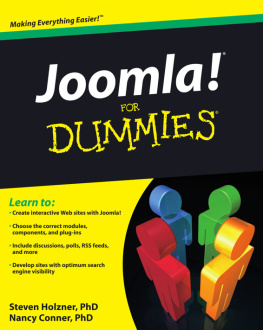
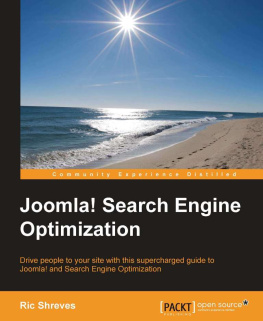
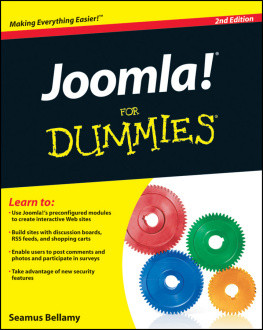



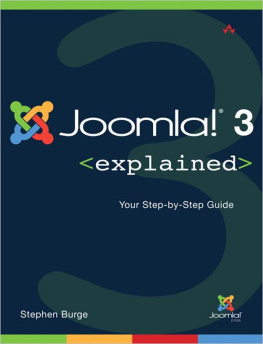
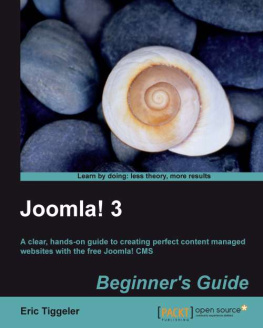
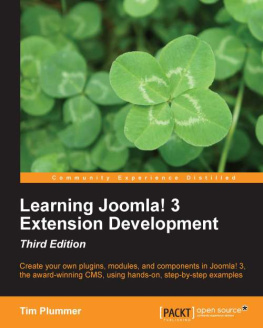

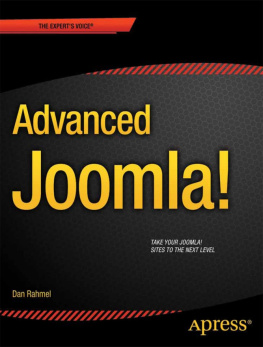
 Build cool Web sites without coding its easy with Joomla! Joomla! makes it easy, and this book makes it easier yet!
Build cool Web sites without coding its easy with Joomla! Joomla! makes it easy, and this book makes it easier yet!


